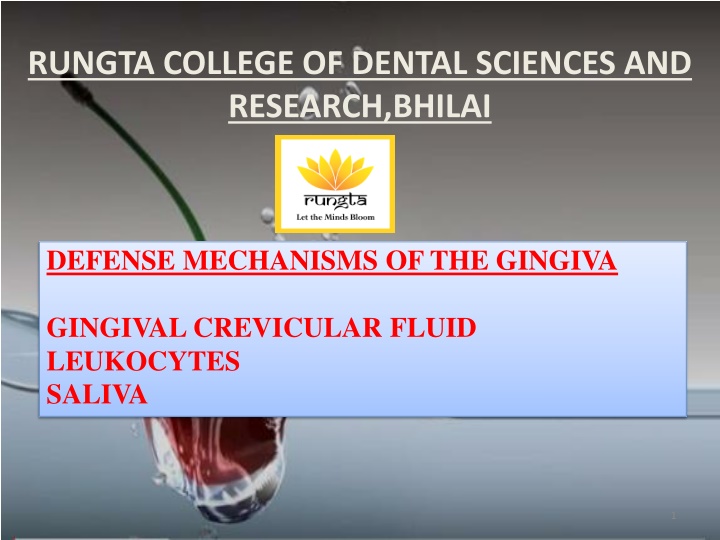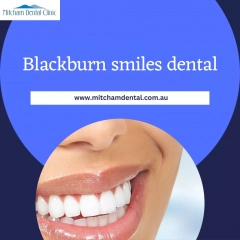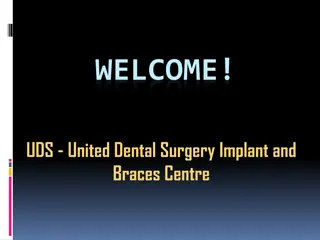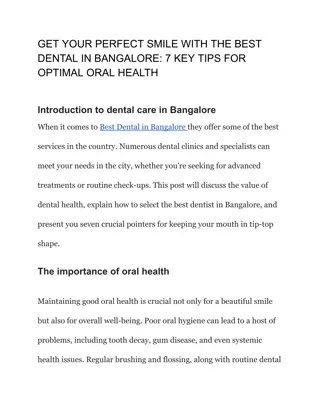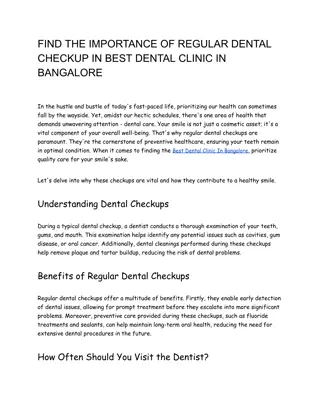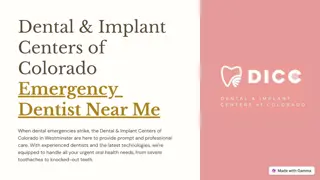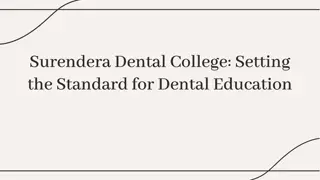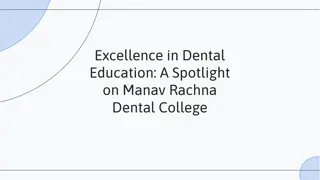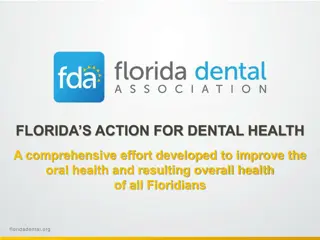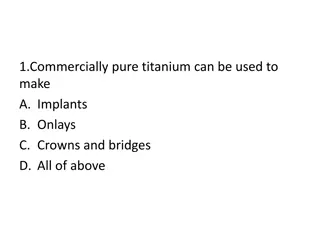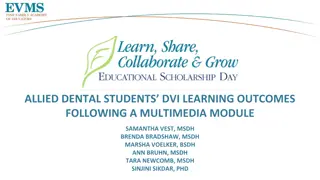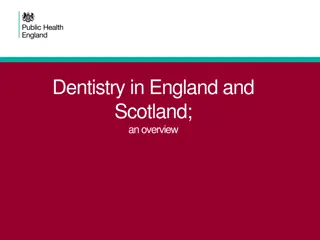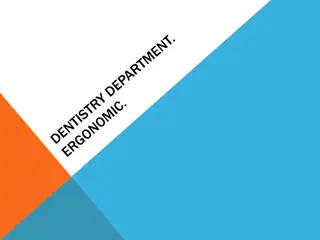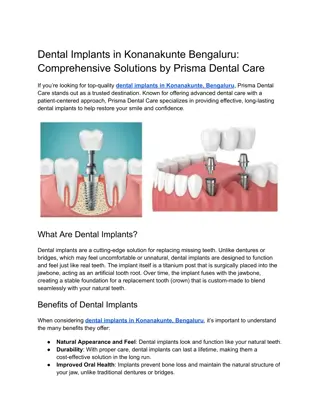RUNGTA COLLEGE OF DENTAL SCIENCES AND RESEARCH,BHILAI
The gingival sulcus acts as a biologic seal, facing challenges from plaque bacteria. Explore the defense mechanisms involving Gingival Crevicular Fluid (GCF), saliva, and leukocytes. Learn about GCF production, collection, composition, clinical significance, and more.
Download Presentation

Please find below an Image/Link to download the presentation.
The content on the website is provided AS IS for your information and personal use only. It may not be sold, licensed, or shared on other websites without obtaining consent from the author.If you encounter any issues during the download, it is possible that the publisher has removed the file from their server.
You are allowed to download the files provided on this website for personal or commercial use, subject to the condition that they are used lawfully. All files are the property of their respective owners.
The content on the website is provided AS IS for your information and personal use only. It may not be sold, licensed, or shared on other websites without obtaining consent from the author.
E N D
Presentation Transcript
RUNGTA COLLEGE OF DENTAL SCIENCES AND RESEARCH,BHILAI DEFENSE MECHANISMS OF THE GINGIVA GINGIVAL CREVICULAR FLUID LEUKOCYTES SALIVA 1
SPECIFIC LEARNING OBJECTIVES CORE AREAS DOMAIN CATEGORY Affective Desire to know INTRODUCTION Cognitive Must to know DEFINITION Cognitive Must to know HISTORY Cognitive Must to know MECHANISM OF GCF PRODUCTION Cognitive Must to know MECHANISM OF GCF COLLETION Cognitive Must to know METHODS OF ESTIMATING GCF Cognitive Must to know COMPOSITION OF GCF Cognitive Must to know CLINICAL SIGNIFICANCE OF GCF Cognitive Must to know SALIVA 2
CONTENT PART I INTRODUCTION DEFINITION HISTORY MECHANISM OF GCF PRODUCTION MECHANISM OF GCF COLLETION PART II METHODS OF ESTIMATING GCF COMPOSITION OF GCF CLINICAL SIGNIFICANCE OF GCF SALIVA 3
The gingival sulcus is an area that provides a biologic seal , but also the area where the plaque bacteria challenge the host. The host however, has exquisite defense mechanisms that involve: - Gingival Crevicular Fluid - Saliva - Leukocytes 5
Gingival Crevicular Fluid (GCF) Tissue fluid that seeps through the crevicular and junctional epithelium. It is increased in the presence of inflammation . Glossary of Periodontal Terms 4th edition 2001 7
HISTORY 8
Early 1950s......Waerhaug focused on the anatomy of the sulcus Late 1950s and early 1960s......Brill et al. ......physiology of GCF formation and its composition. 9
Mid 1960s.....Loe et al 1965 .......the use of GCF as an indicator of periodontal diseases. Cimasoni (1974) published the first edition of the monograph The Crevicular Fluid. 10
MECHANISM OF GCF PRODUCTION 11
The exact nature of the fluid, its origins and composition, has been the subject of controversy. EXUDATE TRANSUDATE 12
Is GCF an inflammatory exudate? The initial investigations of GCF attempted to relate its formation to the inflammatory changes in the connective tissues underlying the sulcular and junctional epithelia. These changes were primarily an increased permeability of the blood vessels, which was induced by chemical or mechanical means. 14
Brill et al 1959 systemically administered fluorescein in dogs. GCF collected using filter paper strips. Fluorescein appeared in the GCF collected. Sample collected from other oral epithelia had not allowed the passage of the fluorochrome, hence, it was concluded that differences in permeability must exist between these oral epithelia and the epithelium lining the gingival pocket. 15
Subsequent experiments showed that the flow of gingival fluid increased markedly following stimulation of the gingivae by: Tooth Brushing By chewing After intravenous injection of Histamine or The development of inflammation. This led to the conclusion that some irritation, whether chemical or mechanical, was necessary to induce the production of GCF and that it should therefore be considered as a PATHOLOGICAL PHENOMENON. 16
Is GCF a TRANSUDATE of interstitial fluid? An alternative theory.........Alfano (1974) and Pashley (1976)........suggested that the initial fluid produced could simply represent interstitial fluid which appears in the crevice as a result of an osmotic gradient. This initial, pre-inflammatory fluid was considered to be a transudate, and, on stimulation, this changed to become an inflammatory exudate. 17
At a clinically healthy gingival crevice Bacterial plaque would result in the accumulation of high molecular weight molecules. These would permeate the intercellular regions of the epithelium, but would then be limited by the basement membrane. An osmotic gradient will be produce which would induce the flow of interstitial fluid from the connective tissue to the gingival sulcus. 18
Mathematical model of Pashley, illustrated within the gingival crevice. (a) Absence of inflammation: low vascular permeability and low permeability of the basement membrane results in low GCF flow and high % uptake by lymph vessels. (b) Macromolecules of plaque result in an osmotic gradient, increased permeability and basement membrane changes, resulting in increased passage of fluid into the increased GCF production. vascular tissues and 19
The methods of collection may be broadly divided into: INTRACREVICULAR EXTRACREVICULAR 21
The techniques can be divided into following basic strategies: Gingival washing methods Capillary tubing or micropipettes Absorbent filter paper strips Preweighed twisted threads 22
Gingival washing methods In this technique the gingival crevice is perfused with an isotonic solution, such as Hanks balanced salt solution, usually of fixed volume. The fluid collected then represents a dilution of crevicular fluid and contains both cells and soluble constituents such as plasma proteins. 23
The simplest method.....Skapski and Lehner 1976 Involved aspiration of 10ml of Hanks balanced salt solution at the interdental papilla. the instillation and re- This process was repeated 12 times to allow thorough mixing of the transport solution and GCF. applied either to individual interdental units or to multiple units 24
A more complicated method......Oppenheim FG 1970 Involved the construction of a customized acrylic stent which isolate the gingival tissues from the rest of the mouth. The tissues were then irrigated for 15min, with a saline solution, using a peristaltic pump, and the diluted GCF was removed. Valuable for harvesting cells from the gingival crevice region. 25
Capillary tubing or micropipettes Following the isolation and drying of a site, capillary tubes of known internal diameter are inserted into the entrance of the gingival crevice. GCF from the crevice migrates into the tube by capillary action and because the internal diameter is known the volume of fluid collected can be accurately determined, by measuring the distance which the GCF has migrated. This technique appears to be ideal as it provides an undiluted sample of native GCF whose volume can be accurately assessed. 26
Absorbent filter paper strips The advantages of the technique are that it is quick and easy to use, can be applied to individual sites and, possibly, is the least traumatic when correctly used. 27
Preweighed twisted threads Weinstein et al ( 1967 ) inserted preweighed twisted threads into the gingival crevice around the tooth, and determined the amount of fluid collected by weighing the sample thread. 28
SUMMARY The presence of GCF or sulcular fluid has been known since 19th century and its compostion and possible role in oral defense mechanisms were elucidated by the pioneering work of Waerhaug and Brill and Krasse. In strictly normal gingiva little or no fluid can be collected. GCF can be collected intrasulcular method and extrasulcular Method. Saliva secretions are protective in nature because they maintain the oral tissues in physiologic state. It has antibacterial, lubricating, cleansing, and buffering action. It also helps in physical protection and tooth integrity. 29
REFERENCE Newman MG, Takei HH, Klokkevold PR, Carranza FA. Carranza s clinical periodontology, 10th ed. Saunders Elsevier; 2007. Lindhe J, Lang NP and Karring T. Clinical Periodontology and Implant Dentistry. 6th ed. Oxford (UK): Blackwell Publishing Ltd.; 2015. Newman MG, Takei HH, Klokkevold PR, Carranza FA. Carranza s clinical periodontology, 13th ed. Saunders Elsevier; 2018. 30
THANK YOU 31
